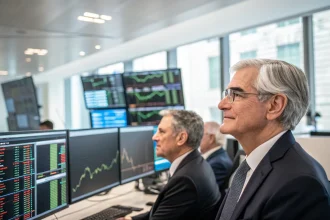Wall Street investors are showing renewed optimism as markets respond to President Donald Trump’s economic growth targets. Financial analysts are closely monitoring the potential for a 4% GDP surge under the incoming administration, with many describing current conditions as approaching a “goldilocks” scenario for investors.
The financial community’s sentiment has shifted notably following recent political developments, with market indicators reflecting growing confidence in economic expansion. This optimism comes as investors reassess their portfolios and strategies in anticipation of policy changes that could accelerate growth beyond current projections.
Trump’s Economic Growth Targets
President Donald Trump has set an ambitious target of 4% GDP growth, significantly higher than recent economic performance. This goal has become a focal point for market participants who are evaluating its feasibility and potential impact across various sectors.
Financial experts note that achieving such growth would require substantial policy changes, including potential tax reforms, deregulation, and infrastructure spending. The administration’s approach to these areas is being closely watched by investors positioning themselves for the coming years.
Some key factors that could influence the achievement of this growth target include:
- Implementation timeline of proposed economic policies
- Federal Reserve’s response to growth-oriented fiscal policies
- Global economic conditions and trade relationships
The “Goldilocks” Market Scenario
Market analysts are increasingly discussing the potential emergence of a “goldilocks” economic environment – one that’s neither too hot nor too cold. This balanced scenario typically features moderate growth with controlled inflation, creating favorable conditions for both equity and fixed-income investments.
A goldilocks market provides the right conditions for sustained investment growth without the overheating that typically leads to aggressive monetary tightening.
Investors are particularly focused on how this balanced growth environment might benefit different asset classes. Equities often perform well in such scenarios, while bonds can maintain stability if inflation remains contained. This has prompted many financial advisors to recommend diversified approaches that can capitalize on multiple growth vectors.
Investment Implications
The combination of optimistic growth targets and potential goldilocks conditions is reshaping investment strategies across Wall Street. Sector rotation has accelerated as investors position for industries likely to benefit most from the anticipated economic expansion.
Financial services, infrastructure, energy, and manufacturing stocks have seen increased interest, reflecting expectations for policy changes that could advantage these sectors. Meanwhile, defensive investments are being reevaluated as risk appetite increases among market participants.
Institutional investors are also adjusting their outlook, with many fund managers increasing their allocation to U.S. equities in anticipation of stronger domestic growth. This shift in capital flows could further support market valuations if economic indicators begin to align with the administration’s targets.
Market volatility may increase in the near term as policies are implemented and their effects become measurable. Analysts recommend that investors maintain disciplined approaches while positioning for potential growth opportunities.
The coming months will be critical as economic data either confirms or challenges the optimistic outlook currently prevailing on Wall Street. Investors will be watching key indicators including employment figures, consumer spending, and early GDP readings to gauge whether the 4% growth target appears achievable under the new administration’s economic agenda.









